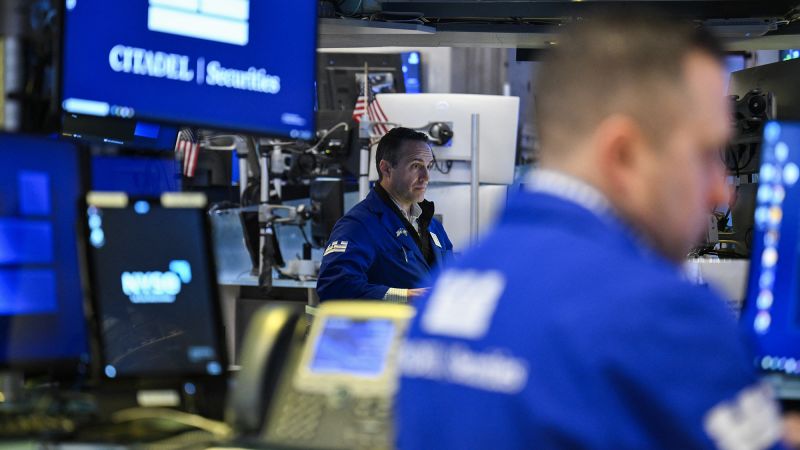April 2023 has been a tumultuous month for financial markets, experiencing fluctuations that have left investors feeling uneasy and speculative about future economic conditions. The month was underscored by an alarming report that revealed a contraction in the U.S. economy for the first time in several years. As a result, stocks faced a notable decline, placing the market in a precarious position as the month drew to a close.
On a troubling afternoon in mid-April, the Dow Jones Industrial Average recorded a dip of 115 points, which translated to a decrease of 0.3%. The S&P 500 experienced a more pronounced drop of 0.6%, while the tech-heavy Nasdaq Composite sank by an even heftier 1%. This downfall followed a morning marked by a sell-off that extended into the afternoon, showcasing the market’s turbulent response to the recent economic data.
The turmoil was largely triggered by a data release from the Commerce Department which disclosed a contraction in the U.S. economy during the first quarter, the first such occurrence since 2022. This unsettling news was further exacerbated by the ongoing uncertainty surrounding former President Donald Trump’s policy initiatives. His administration’s tariffs have not only injected doubt into the business community but have also negatively influenced consumer confidence, leading to a cautious sentiment in financial environments.
However, some positivity peeked through the tumult when new data suggested inflation rates had slowed down in March. The Federal Reserve’s favored inflation measure showed signs of cooling, eliciting a brief sense of relief among investors. At this juncture, market analysts regarded this inflation easing as an encouraging sign, although concerns lingered regarding Trump’s tariffs that are anticipated to elevate prices in the near future.
After a rally over the previous week where the S&P 500 and Dow marked victories for six consecutive days, both indexes were now poised to end the month with losses. Their long streak of gains was abruptly halted, predominantly due to the repercussions of the tariffs imposed by Trump). At the start of April, the S&P 500 saw its worst performance in decades, shedding more than 11% in just the first eight days. Despite a recent recovery following Trump’s announcement of a 90-day hiatus on many of the tariffs, the index was unexpectedly set to close the month around 2% lower.
Trump, appearing unperturbed on his social media platforms, attributed the current stock situation to the Biden administration’s impact rather than his tariffs. He claimed, “This is Biden’s Stock Market, not Trump’s,” attempting to shift the focus away from the detrimental market effects his policies have had. Trump asserted that forthcoming tariffs would catalyze onshoring efforts in American companies and continue to bolster the U.S. economy, despite the pervasive apprehension regarding his administration’s fiscal policies.
The political dynamics were further complicated by statistics indicating that the stock market performance during Trump’s second presidential term was among the poorest during the initial hundred days when compared to other presidents. This downturn followed a stark contrast to the stock boom seen in his first term and during Biden’s administration.
As conversations about potential recession loomed, investors grappled with the reality of whether the markets would navigate a downturn or recover in due time. The job market also reflected a cooling trend, with private sector job growth plunging from 147,000 in March to only 62,000 in April, as reported by ADP. Describing the environment, Nela Richardson, an economist at ADP, articulated that “unease is the word of the day.”
As the month progressed, it became clear that the volatility extending into the Treasury market was a test of the administration’s tariff policies. Analysts noted that typically, downturns in stock prices lead investors to seek stability in government bonds; however, this time, all three American assets faced significant volatility.
Despite the market apprehension, hope persists among industry experts for a potential recovery over the coming months. However, opinions vary on how soon and how effective the recovery may be. Observers continue to monitor how external factors, particularly those influenced by Trump’s policy decisions, might determine future market stability. The dialogue amongst financial strategists suggests that the pitfalls of Trump’s tariffs could linger, prompting ongoing volatility and unpredictability in stock trading.
In conclusion, the events unfolding in April highlight the interdependence of economic policy and market sentiment. The uncertainty surrounding Trump’s actions, coupled with a cautious labor market, has fostered an environment of volatility that may characterize the months ahead. The road to recovery may thus require more than just time; it will demand astute navigation of economic policies and investor sentiments. The narrative remains complex and is evolving, with analysts keenly watching how the variables play out in real-time.



